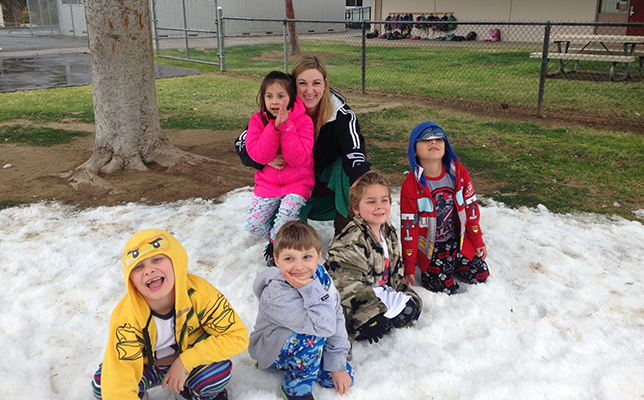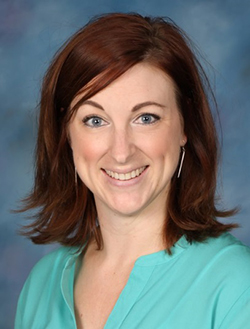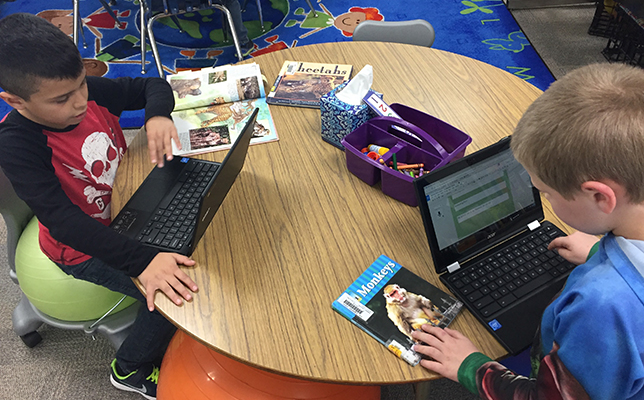Simi Valley, CA Innovator Uses Tech to Help Emotionally Challenged Kids
Jamie Reese was selected Teacher of the Year for Ventura County last year.

Jamie Reese, center, and her students at Mountain View Elementary School.
Jamie Reese, a kindergarten through third grade teacher at Mountain View Elementary School in Simi Valley, CA, holds the distinct honor of winning Teacher of the Year for Ventura County in 2016. She’s the first Simi Valley teacher to receive that award since 1977.

A Google Certified Educator and Amazon Education Innovator, Reese instructs students with emotional disturbances, and embraces technology as a method to connect with them and keep them engaged throughout the day.
The 33-year-old Simi Valley native has used virtual reality to take her students to far-flung places like Antarctica. In her classroom, she wears a microphone connected to Lightspeed Technologies’ Topcat and Flexcat audio systems. She also uses many other education technologies to achieve maximum results with a challenging group of special education students.
THE Journal: Describe how Topcat and Flexcat help you with your students.
Jamie Reese: A lot of research that shows that among kids, (amplification) decreases special ed referrals. It’s beneficial for all to access the curriculum, not just kids hard of hearing. I can also change the tone of my classroom. I no longer have to use my teacher voice, so to speak. The students are able to hear me, and access the system anywhere in the room.
With this population, raising your voice at all can be triggering for them. We can negate that factor. I do not have to modulate my voice a whole lot. For our general education teachers, they’re less fatigued at the end of the day. Projecting your voice takes a lot out of your body.
THE Journal: Do you remember a time when you weren’t using technology in the classroom, and have you seen an improvement in teaching and learning since you have?
Reese: I would say yes. Even during my time in special education (eight years), I’ve seen the change. Now we have smart interactive displays and cameras as well. The benefit is, I’m getting to meet kids in their world. They’ve never known a world without the internet or without iPads. Some of the ways we used to teach — it doesn’t make sense to them. My room has shifted from being teacher-centered to student-centered. They have much more ownership over their learning.
THE Journal: Some old-school teachers might argue that incorporating technology into one’s teaching requires more work and sucks up more personal time.
Reese: It does take a lot of time. It’s definitely a shift — it’s going to be a lot of work. But you have to change your habits. So really, it’s actually knowing what the standards are and making them really accessible. Curriculum doesn’t drive the learning. You really need to know what the standards are, and make sure you’re referring to them. But these days we’re seeing a lot more student-centered learning.
THE Journal: You told me you’ve gone 1-to-1 with computer devices in your classroom. Describe that, and which do you prefer, the Chromebook or the iPad?

Students in Jamie Reese's class work on their Chromebooks.
Reese: We were 1-to-1 iPad, and we recently got a Chromebook cart. We just initiated that; this is our first year. We actually have both now. Based on some of the work we’ve done, our district is moving to a 1-to-1 Chromebook model. We have 600 teachers who are getting trained.
I think the Chromebook is preferable. In my experience that I did piloting both, and now having access to both, I find that the iPad is more of a consumption of material device. The Chromebook is more of a creating device. I use Chromebooks to get them creating things — pixel art, colors down the side, learn to format cells. The pixel art is a Minecrafty type of pixilation they do.
THE Journal: What is Genius Hour?
Reese: It’s based on an effort that started at Google, which allows its engineers to spend 20 percent of their work time on a project of their own choosing. They can play and research things that they’re interested in, and a lot of new projects and ideas have come out of that.
For my students, Genius Hour is when they get to self-select a topic they want to learn about. Typically it’s about an animal or an insect. I’ve created a hyper doc in Google Docs for them to work on these projects. It actually fits right in with the Common Core — they do research, presentation and make some kind of visual.
THE Journal: How do you use Twitter to help other teachers?
Reese: I do a lot of training for teachers using Twitter as a professional development tool. We run a Twitter chat every Sunday night. It’s not just educators. People from other states and countries join in. We just make sure we have moderators and topics. The trainings are on how Twitter can make you a better teacher.
There was a study that indicated out of all the tweets in 2014, 4.5 billion were related to education. Twitter is a huge platform to be learning, sharing ideas, talking about resources that are relevant. Tons of authors that publish books on education are on Twitter — “Teach Like a Pirate” (by Dave Burgess), “Innovator’s Mindset” (by George Couros). They respond to tweets, and one might do a Google Hangout with us. It’s really just an unlimited wealth of information for teachers. So you don’t spend all your time on Twitter, hashtags really help you filter what’s out there. You have to use it in a very targeted way.
THE Journal: What are some other education technology products you use?
Reese: Google Slides, Docs and Forms. I have a Google Form I’ve created. Students can type in their lunch number, name, how they’re feeling. They can set a goal for themselves each day, such as learning to navigate the trackpad.
I use Seesaw, a digital portfolio tool that parents can connect to. Parents get notified and can leave voice or written comments. Each student in a classroom has an account where they can add pictures, videos and upload work. Then I have the choice to post it to our website. If I don’t, only their families can see it.
I use Google Classroom, Expeditions. We went on a “field trip” where we got to use the Expeditions. We’ve purchased our first kit. As far as teacher usability, Google far surpasses anything else.
THE Journal: Does technology help you teach emotionally challenged students?
Reese: Yes. For my population of students specifically, they don’t have learning disabilities. They’re mostly emotionally challenged. Tech is engaging and of high interest to them. I can start building rapport with them, and building relationships with them. It’s a gateway for me to start building that relationship. They’re mostly kids who have trouble regulating behavior in a school setting. For kids that have anxiety around school, it definitely engages them and brings some level of familiarity.
There are some things they can teach me, too. I work very hard to stay current and keep tech savvy, but the kids take to it very quickly. I find technology a successful tool and it goes a long way toward building trust.
About the Author
Richard Chang is associate editor of THE Journal. He can be reached at [email protected].